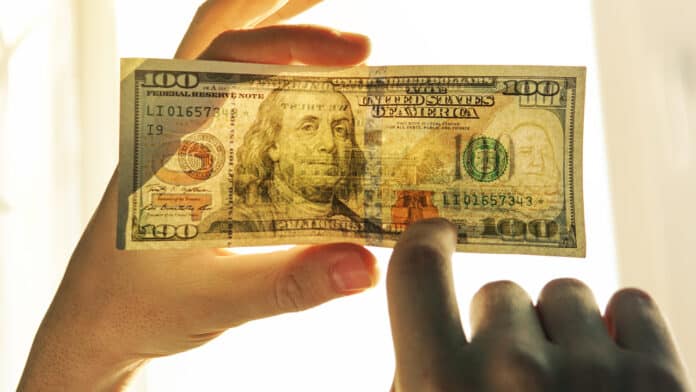How To Tell Real Money From Counterfeit

Though UV counterfeit detection lamps and counterfeit money pens are helpful tools, there are many other ways to tell if a bill is authentic or counterfeit. Concrete characteristics of the banknote, such as ink, watermarks, and text, are intentional security measures to assistance people recognize authentic money.
When retail associates learn how to spot a faux $100 bill, they can help reduce the chances of a business concern suffering a loss of thousands of dollars. Hither is a list of 8 ways to tell if a bill is real or apocryphal:
1. Color-shifting Ink
One of the showtime things to bank check to come across if a pecker is authentic is if the bill denomination on the lesser right-hand corner has color-shifting ink. Going back to 1996, all bills of $5 or more have this security feature. If you concord a new series pecker (except for the new $5 bill) and tilt it back and forth, you tin can see that the numeral in the lower correct-hand corner shifts from light-green to black or from gilded to green.
2. Watermark
The watermark is a characteristic security feature of authentic banknotes. Many of the new bills utilise a watermark that is actually a replica of the face on the nib. On other banknotes, it is but an oval spot. Here are some things to continue in mind when looking at a bill's watermark:
• The watermark should only be visible when you hold the neb upwards to the lite.
• The watermark should be on the right side of the bill.
• If the watermark is a confront, it should exactly lucifer the face on the pecker. Sometimes counterfeits bleach lower bills and reprint them with higher values, in which case the face wouldn't match the watermark.
• If there is no watermark or the watermark is visible without beingness held upwards to the light, the nib is most likely a counterfeit.
3. Blurry Borders, Printing, or Text
An automatic red flag for counterfeit bills is noticeably blurry borders, printing, or text on the bill. Accurate bills are made using die-cutting printing plates that create impressively fine lines, so they look extremely detailed. Counterfeit printers are unremarkably not capable of the same level of detail. Accept a close wait, especially at the borders, to see if there are any blurred parts in the bill. Authentic banknotes also have microprinting, or finely printed text located in various places on the nib. If the microprinting is unreadable, even under a magnifying glass, it is probably apocryphal.
4. Raised Printing
All authentic banknotes have raised printing, which is difficult for counterfeiters to reproduce. To detect raised printing, run your fingernail advisedly down the note. You should feel some vibration on your nail from the ridges of the raised printing. If you don't feel this texture, then you should cheque the bill further.
5. Security Thread with Microprinting
The security thread is a thin imbedded strip running from top to lesser on the face of a banknote. In the $10 and $50 bills the security strip is located to the right of the portrait, and in the $five, $twenty, and $100 bills it is located just to the left.
Authentic bills have microprinting in the security thread equally another layer of security. Below is a listing of the microprinted phrases on authentic banknotes:
• $5 pecker says "United states of america Five"
• $ten neb says "USA TEN"
• $20 bill says "U.s.a. TWENTY"
• $50 pecker says "USA 50"
• $100 neb says "The states 100"
half-dozen. Ultraviolet Glow
Counterfeit detection tools and technology employ ultraviolet calorie-free because this is a clear-cut way of telling if a pecker is counterfeit. The security thread on authentic bills glow under ultraviolet low-cal in the following colors:
• $v nib glows blue
• $10 bill glows orange
• $20 bill glows light-green
• $50 beak glows yellow
• $100 pecker glows blood-red/pinkish
vii. Blood-red and Blue Threads
If you have a close look at an accurate banknote, y'all can see that there are very pocket-sized red and blueish threads woven into the textile of the beak. Although counterfeit printers attempt to replicate this effect past printing a pattern of cherry-red and blueish threads onto apocryphal bills, if you tin see that this printing is but surface level, and so it is likely the bill is counterfeit.
eight. Series Numbers
The last thing to check on a nib is the serial number. The letter that starts a bill'southward serial number corresponds to a specific year, so if the letter of the alphabet doesn't friction match the year printed on the pecker, information technology is counterfeit. Beneath is the listing of letter-to-year correspondence:
• Eastward = 2004
• Thousand = 2004A
• I = 2006
• J = 2009
• L = 2009A
These security measures were designed not just to deter criminals from attempting to counterfeit money but to aid people and businesses recognize counterfeit coin when they encounter information technology. If y'all run across even i error that could mean a bill is counterfeit, you should report it to the U.S. Currency Educational activity Program to protect yourself from existence held liable for any losses and to inform the Federal Reserve about counterfeit bills in circulation.
This article was originally published in July 2019 and update in Baronial 2021.
Source: https://losspreventionmedia.com/8-ways-to-spot-counterfeit-money/
Posted by: livingstonantley.blogspot.com

0 Response to "How To Tell Real Money From Counterfeit"
Post a Comment